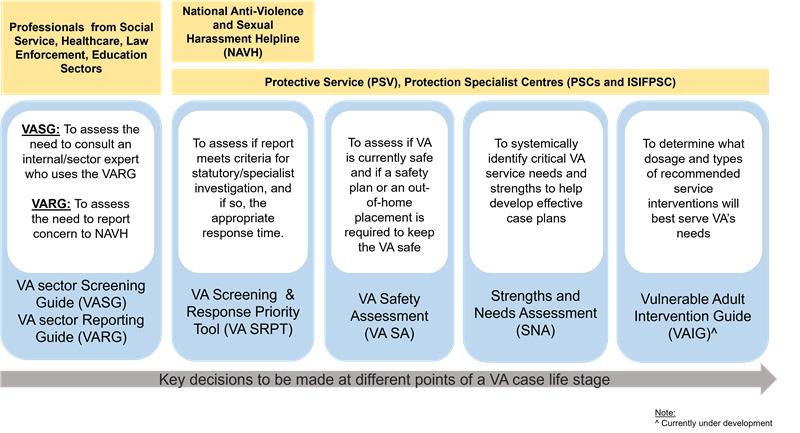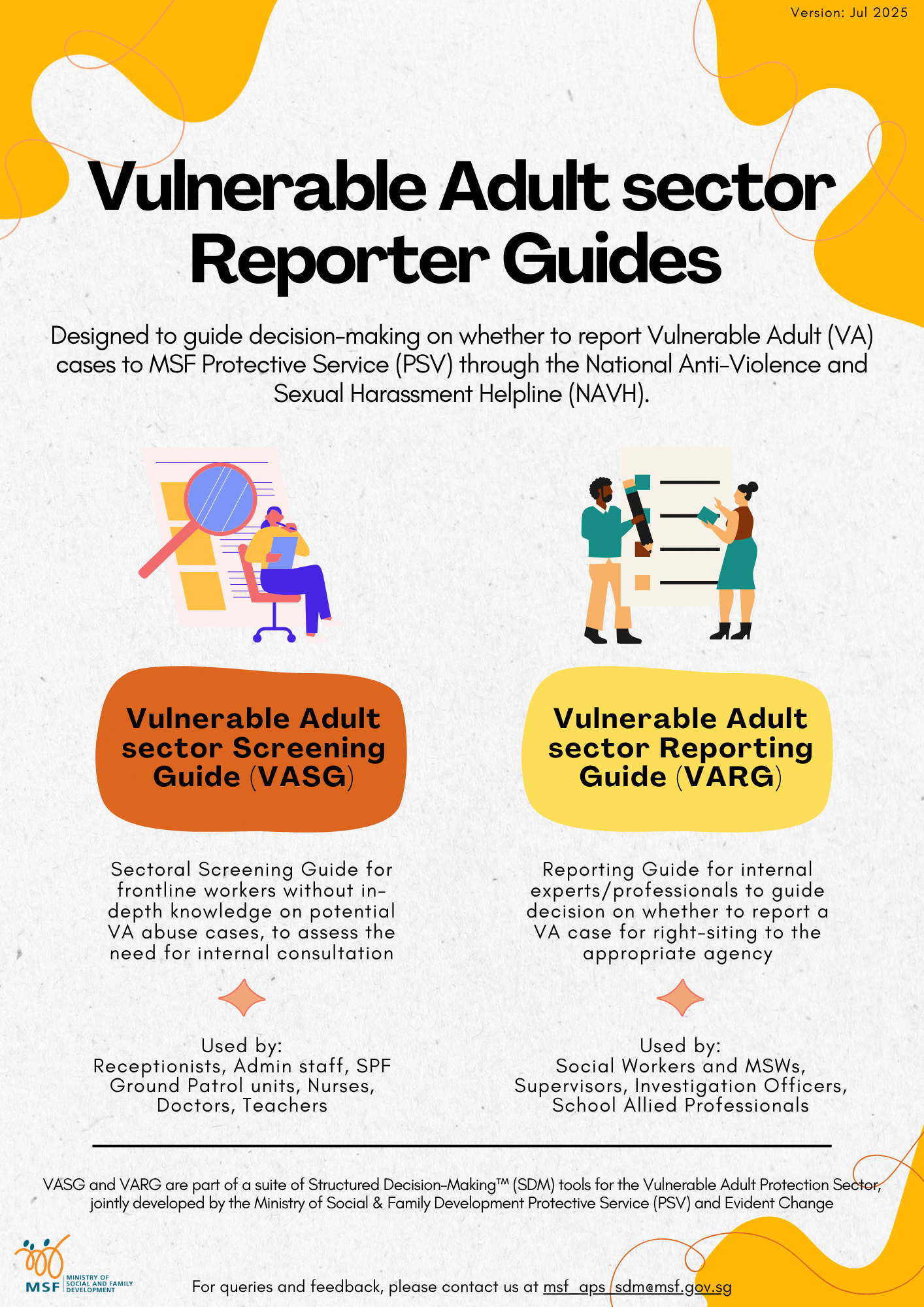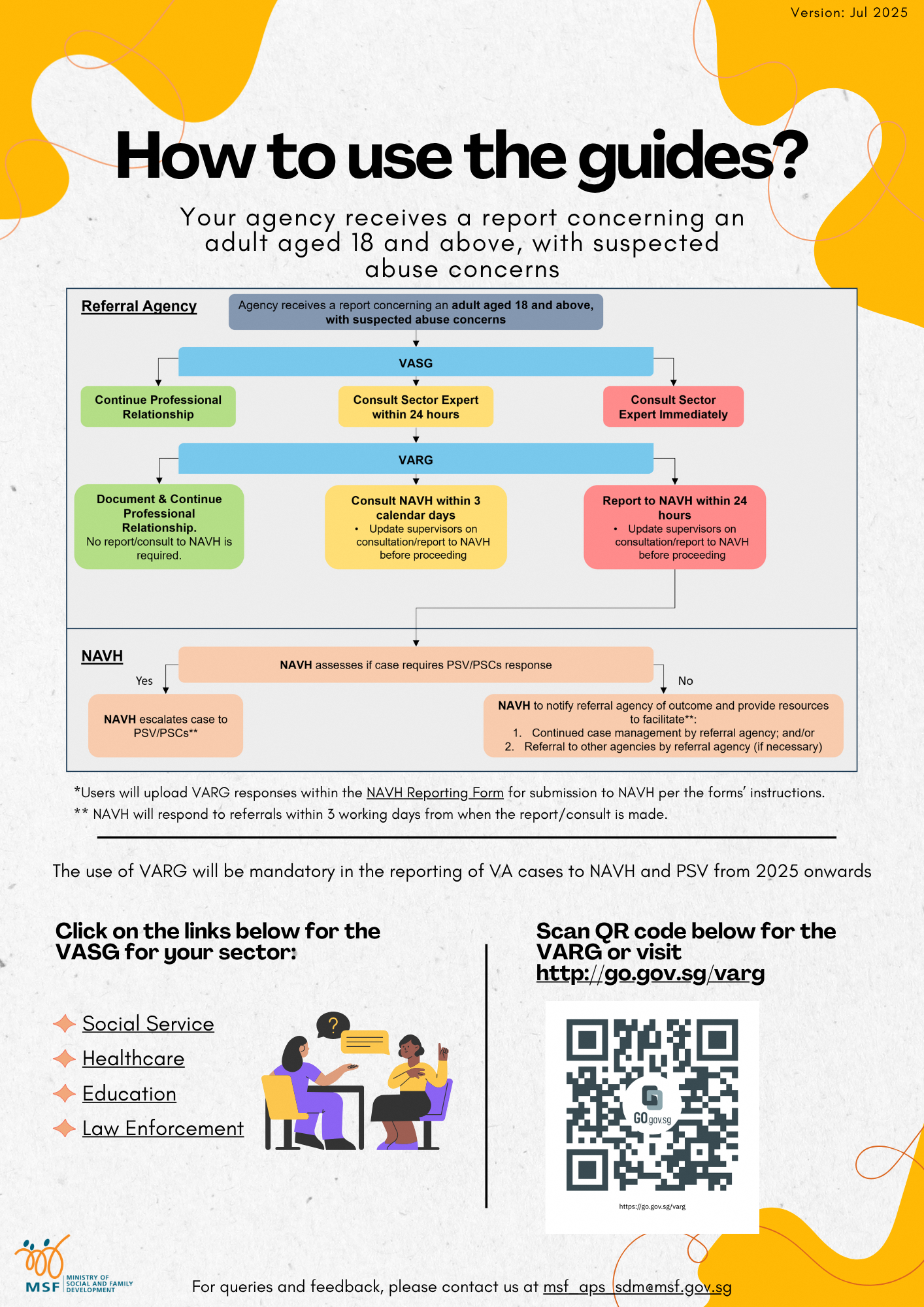Test header
Vulnerable Adult Reporting Tools
Information on Vulnerable Adult sector Screening Guide (VASG) and Vulnerable Adult sector Reporting Guide (VARG).
Who is this page for?
This page is relevant for professionals who work with vulnerable adults and/or families. This includes medical social workers, professionals from the elderly and disability services sector, social service agencies and Courts, etc.
A Vulnerable Adults is a person aged 18 years and above, and is by reason of mental or physical infirmity, disability or incapacity, incapable of protecting himself or herself from abuse, neglect or self‑neglect.
Since late 2013, MSF has worked with Evident Change (formerly then known as the National Council on Crime & Delinquency and Children’s Research Centre) and sector partners to adapt and localise the SDM® system for use in Singapore. MSF rolled out the SDM® system in 2023 to support professional judgement in making decisions affecting the safety of vulnerable adults.
The infographic below provides an overview of Vulnerable Adult SDM® tools and the agencies that employ them.

The Vulnerable Adult sector Screening Guide (VASG) and Vulnerable Adult sector Reporting Guide (VARG) are Structured Decision Making® (SDM®) tools designed to assist the community in accurately assessing and reporting cases involving vulnerable adults. Using a structured approach to development and evaluation, these guides ensure consistent categorization and appropriate intervention for vulnerable adults at need.
- Vulnerable Adult sector Screening Guide (VASG)
The VASG is a sectoral screening guide used by frontline professionals without in-depth knowledge on potential VA abuse related cases, to guide them on whether the concern should be discussed with someone in their organization who is trained in VARG.
- Vulnerable Adult sector Reporting Guide (VARG)
The VARG is a reporting guide for internal experts and professionals more familiar with vulnerable adult issues to guide their decision on whether to report a concern to the National Anti-Violence and Sexual Harassment Helpline (NAVH), or take alternative action.
MSF has trained professionals from four sectors (i.e. social service, healthcare, law enforcement, and education) to use the VASG and VARG. For more information on training matters, please visit the training information tab.
- The VARG and VASG would enhance service delivery by having a common language and consistent assessment amongst key sector partners in the VA protection landscape. This would increase clarity and timeliness in right-siting of reported cases, escalation level and tiers of intervention, thereby increasing communication and coordination across agencies in supporting vulnerable adults in Singapore.
- As a professional, you will be guided in reporting the right information at the right time to the right agency. This reduces the time and resources needed for information gathering.
- When cases are referred to the right agencies, vulnerable adults at risk can receive timely intervention from the appropriate agency most suited for their situation. Within the community, MSF has also set up and trained Protection Specialist Centres (PSCs) to serve as specialists, and provide less-intrusive interventions early to keep vulnerable adults safe.
- You will be able to help MSF’s Protective Service (PSV) to concentrate on the most serious reports of abuse, which requires higher levels of interventions that are more intrusive.
PSV and NAVH uses another SDM tool, the Vulnerable Adult Screening and Response Priority Tool (VA SRPT) to determine whether a case should be screened into PSV. When a concern is reported, NAVH or PSV workers will gather more information. The VA SRPT guides NAVH and PSV’s decision on whether the case needs to be investigated by PSV, or if the affected vulnerable adult’s needs can be better addressed by another agency. This means that even for situations where VARG’s outcome is to report to PSV or NAVH, the situation may not warrant an immediate intervention by PSV.
The VASG and VARG are meant to ensure that professionals report any potential abuse, neglect, and exploitation of vulnerable adults so that PSV can review the information and make appropriate determinations. If reported concerns are not screened in for intervention, it does not mean the guide did not function properly or that you did your job incorrectly, or that the guides are not useful. Some reports will screen in and some will not – this is to be expected. VASG and VARG are there to ensure nothing falls through the cracks before it reaches PSV.
| SDM™ Assessment Tools | Who uses them? | Key decisions for user to make | Key benefits |
| Vulnerable Adult sector Screening Guide (VASG) | Frontline professionals without in-depth knowledge on potential VA protection related cases (e.g. Receptionists, First Responders, Clinical Staff, Teachers) | Should I discuss a concern regarding a suspected vulnerable adult with a VARG user? |
|
| Vulnerable Adult sector Reporting Guide (VARG) | Internal experts and professionals more familiar with VA protection issues (e.g. Social Workers, Medical Social Workers, Head of Departments) | Should I report a concern to NAVH? |
|
| Vulnerable Adult Screening & Response Priority Tool (VA SRPT) | NAVH, PSV | Should NAVH screen in the case to PSV to undertake an investigation? |
|
Introductory Video on VARG and VASG
The Vulnerable Adult sector Screening Guide (VASG) and Vulnerable Adult sector Reporting Guide (VARG) are Structured Decision Making® (SDM®) tools designed to assist the community in accurately assessing and reporting cases involving vulnerable adults. They guide professionals to make the decision on whether to report a concern to the National Anti-Violence and Sexual Harassment Helpline (NAVH), or take alternative action.


The Vulnerable Adult Screening Guide (VASG) assists professionals who are concerned about possible abuse, neglect or self-neglect of a vulnerable adult (VA). It is a resource that guides a decision whether to consult an internal and/or sector expert, who can then assess the need to report the concerns to the National Anti-Violence and Sexual Harassment Helpline (NAVH).
Target audience includes professionals from the education, healthcare, law enforcement and social service sectors.
By the end of the course, learners will be able to:
- Describe the VASG purpose and decision point
- Explain the sections and items in the VASG
- Apply the VASG in practice
The Vulnerable Adult Reporting Guide (VARG) provides structure for reporters who are concerned about possible abuse or neglect of an adult so they can assess the need to report the concerns to the National Anti-Violence and Sexual Harassment Helpline (NAVH). The VARG aims to:
- Assist reporters in gaining familiarity with the reporting threshold
- Ensure vulnerable adults (VAs) get the needed protective service
- Provide alternative options for reporters to assist VAs who would be better served by community agencies
Target audience includes professionals from the education, healthcare, law enforcement and social service sectors.
By the end of the course, learners will be able to:
- Describe the purpose and decision point of the VARG
- Explain the VARG’s sections and items
- Apply the VARG in practice
- VASG E-Learning (Course Code SSI0165): Structured Decision Making – Vulnerable Adult Screening Guide (VASG) - Social Service Institute
- VARG E-Learning (Course Code SSI0166): Structured Decision Making – Vulnerable Adult Reporting Guide (VARG) - Social Service Institute
General
1. What is the Vulnerable Adult sector Screening Guide (VASG) and Vulnerable Adult sector Reporting Guide (VARG)?
The VASG and VARG are Structured Decision Making® (SDM®) tools designed to assist the community in accurately assessing and reporting cases involving vulnerable adults. Using a structured approach to development and evaluation, these guides ensure consistent categorization and appropriate intervention for vulnerable adults at need.
2. Who uses the VASG and VARG?
The VASG is a sectoral screening guide used by frontline professionals without in-depth knowledge on potential VA abuse related cases, to guide them on whether the concern should be discussed with someone in their organization who is trained in VARG.
The VARG is a reporting guide for internal experts and professionals within each organization that are more familiar with vulnerable adult issues to guide their decision on whether to report a concern to the National Anti-Violence and Sexual Harassment
Helpline (NAVH), or take alternative action.
If you are a professional who interacts with vulnerable adults on a regular basis, you are encouraged to sign up for the VASG and/or VARG e-learning through the Social Service Institute portal^:
- VASG E-Learning (Course Code SSI0165): Structured Decision Making – Vulnerable Adult Screening Guide (VASG) - Social Service Institute
- VARG E-Learning (Course Code SSI0166): Structured Decision Making – Vulnerable Adult Reporting Guide (VARG) - Social Service Institute
^The SSI learning portal is undergoing an update and e-learning courses will not be available from 15 Sep 2025. Course registration will re-open again on 15 Nov 2025.
3. How were the VASG and VARG developed?
From 2023 to 2024, PSV and Evident Change (US-based non-profit organisation) had engaged key sector partners from the education, healthcare, law enforcement and social service sectors in Singapore to co-develop and test the VARG and VASG. Using a structured approach to development and evaluation, these guides ensure consistent categorization and appropriate intervention for vulnerable adults at need.
Training
1. Who should attend VASG and VARG User training?
Professionals who interact with vulnerable adults on a regular basis or encounter vulnerable adult protection issues through their work are encouraged to attend VASG and VARG training.
2. What are the eligibility criteria for VASG and VARG User training?
There are no eligibility criteria for VASG or VARG e-learning modules.
3. What is the duration of the VASG and VARG User training?
The VASG and VARG e-learning modules take about 30 minutes each to complete.
4. What is the frequency of VASG and VARG User training?
You may register for the e-learning at any time. Visit the following links to sign up today^:
- VASG E-Learning (Course Code SSI0165): Structured Decision Making – Vulnerable Adult Screening Guide (VASG) - Social Service Institute
- VARG E-Learning (Course Code SSI0166): Structured Decision Making – Vulnerable Adult Reporting Guide (VARG) - Social Service Institute
^The SSI learning portal is undergoing an update and e-learning courses will not be available from 15 Sep 2025. Course registration will re-open on 15 Nov 2025.
5. Where can I obtain the latest version of the VASG/VARG manuals?
You are encouraged to sign up for the VASG/VARG e-learning courses on Social Service Institute (SSI)’s portal (links below) to access the latest e-learning modules and manuals^.
- VASG E-Learning (Course Code SSI0165): Structured Decision Making – Vulnerable Adult Screening Guide (VASG) - Social Service Institute
- VARG E-Learning (Course Code SSI0166): Structured Decision Making – Vulnerable Adult Reporting Guide (VARG) - Social Service Institute
^The SSI learning portal is undergoing an update and e-learning courses will not be available from 15 Sep 2025. Course registration will re-open on 15 Nov 2025.
Enquiry
1. If I have questions about VASG and VARG e-learning modules, who should I contact?
You may email your enquiry to SocialServiceInstitute@ncss.gov.sg.
2. I am a trained VASG / VARG user. Who should I consult if I have further questions about the VASG / VARG outcome even though the outcome is to consult NAVH?
Please consult your organisation’s trained VARG user, or the National Anti-Violence and Sexual Harassment Helpline (NAVH) through this form: https://go.gov.sg/navh-revised-reporting-form
* Since May 2025, Child Protective Service and Adult Protective Service have been merged to form the Protective Service.